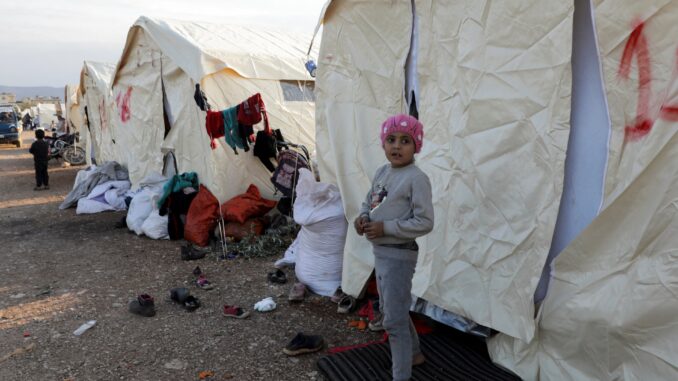
Aid groups and public health experts warn that a series of devastating earthquakes could exacerbate a cholera outbreak in Syria first detected last year.
The warnings come as rescue operations ceased in both opposition and government-held portions of Syria – and hope diminished amid remaining searches in Turkey – six days after a series of quakes hit the region. As of Sunday, the death toll topped 35,000 in the two countries, with at least 4,500 dead in Syria.
Across war-torn Syria, where the UN has estimated that 5.3 million people have been left homeless by the disaster, “there was a perfect storm brewing before the earthquake – of increasing food insecurity, collapsing healthcare systems, the lack of access to safe water and poor sanitation”, said Eva Hines, chief of communications for the United Nations Children’s Fund (UNICEF) in the Syrian capital, Damascus.
“More than half of people in Syria depend on unsafe alternative water sources when it comes to their water needs. And that, of course, increases vulnerability to fast-spreading waterborne diseases such as cholera,” Hines told Al Jazeera.
In September last year, the Syrian government declared an outbreak of cholera – a diarrhoeal infection caused by ingesting food or water contaminated by the Vibrio cholerae bacteria. The disease can prove deadly, particularly for children.
The outbreak was largely attributed to the country’s war-ravaged water infrastructure, which forced residents to drink and irrigate fields with contaminated water from the Euphrates river in the country’s northeast.
The disease quickly took hold of largely opposition-held swaths of northwest Syria, where at least 1.7 million people displaced by the country’s decade-long civil war live in crowded camps, and about four million were reliant on humanitarian aid prior to the disaster.
As of January 18, nearly half of the suspected 77,500 cases of cholera in the country were in the northwest region, according to the United Nations Office for the Coordination of Humanitarian Affairs (OCHA), with 18 percent detected in camps for the internally displaced.
Meanwhile, more than 2.1 million people in northwest Syria live in “the most at-risk subdistricts for developing a cholera outbreak”, according to OCHA.
Marc Schakal, programme director for Syria and Turkey for Doctors Without Borders (Medecins Sans Frontieres, or MSF), which operates in opposition-held areas, told Al Jazeera: “There were very serious difficulties and concerns about the general infrastructure of [the internally displaced camps], and now it’s even more because of the damage in terms of urban and other areas.”
He said the increased risk of cholera is among an array of compounding public health risks in areas controlled by armed opposition groups, where 37 health facilities were damaged in the quake and 20 were forced to suspend part or all of their operations. Schakal added that the disaster has also upended the treatment of chronic-disease patients and has increased mental health concerns.
The pre-existing rate of cholera infection in Syria increases the chances of a wider spread, Ilan Kelman, a professor of Disasters and Health at University College London, told Al Jazeera.
Major earthquakes typically cause disruptions to sanitation and clean water access and force populations into crowded temporary camps or shelters, he said. That, in turn, leads to an increase in diseases such as cholera, typhoid and typhus.
However, those diseases “generally do not occur post-disaster unless they are already present”, he said.
For instance, following the 2010 earthquake in Port-au-Prince, Haiti, a cholera outbreak was later traced to UN peacekeepers deployed to the Caribbean island, not residents. The outbreak led to more than 9,000 deaths.
“In most cases, a disease has to be endemic or already present to expand after disaster,” Kelman told Al Jazeera. “And cholera is present in Syria, which is why there is a major concern at the moment and, yeah, it could absolutely end up crossing borders to Turkey if the appropriate hygiene measures are not taken.
“In the immediate post-disaster environment, the risk of already present disease is immediately heightened. It is both an immediate threat as well as a slow burn risk.”
Meanwhile, rescuers say the slow delivery of humanitarian aid to opposition-held northwest Syria, where there is only one UN-approved border crossing with Turkey, has severely hampered efforts during the crucial hours and days following the initial quakes.
Now, the barriers to aid delivery risk are exacerbating an array of knock-on threats, MSF’s Schakal said.
“Turkey is receiving international aid and search-and-rescue teams from different countries, and it’s very appreciated and very valuable and needed, but today Syria is left a bit on the side,” he said.
“There is some aid arriving now in Syria, but we are day six from the earthquake. Our teams cannot do everything without external support. And for the moment, there is very little reinforcement of resources.”
With first cases detected in September, earthquake devastation risks new stresses, particularly in rebel-held areas.



